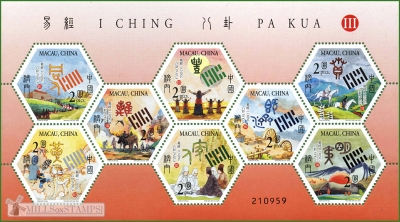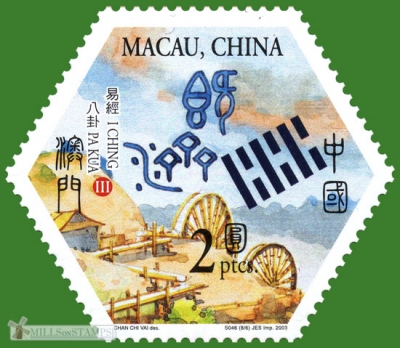-
I Ching, Book of Changes. Part III
Macau 2003.09.10
In issue: Stamp(s): 8 Souvenir sheet(s): 1
Printing: multicolor
Issued in: miniature sheets of 8 stamps as one set
-
Number by catalogue: Yvert: 1171 Scott: 1126e
Perforation type: 14x14
Subject:
2 patacas. Hexagonal stamp. On the stamp are hexagramm "jì jì" and Irrigation wheels
Additional:
*The I Ching (Wade-Giles), “Yì Jīng” (Pinyin), Classic of Changes or Book of Changes; also called Zhouyi, is one of the oldest of the Chinese classic texts. The book is a symbol system used to identify order in random events.
The text describes an ancient system of cosmology and philosophy that is intrinsic to ancient Chinese cultural beliefs. The cosmology centres on the ideas of the dynamic balance of opposites, the evolution of events as a process, and acceptance of the inevitability of change.
In Western cultures and modern East Asia, the I Ching is sometimes regarded as a system of divination. The classic consists of a series of symbols, rules for manipulating these symbols, poems, and commentary.Traditionally it was believed that the principles of the I Ching originated with the mythical Fu Xi (伏羲 Fú Xī). In this respect he is seen as an early culture hero, one of the earliest legendary rulers of China (traditional dates 2800 BCE-2737 BCE), reputed to have had the 8 trigrams (八卦 bā gùa) revealed to him supernaturally. By the time of the legendary Yu (禹 Yǔ) 2194 BCE–2149 BCE, the trigrams had supposedly been developed into 64 hexagrams (六十四卦 lìu shí sì gùa), which were recorded in the scripture Lian Shan (《連山》 Lián Shān; also called Lian Shan Yi). Lian Shan, meaning “continuous mountains” in Chinese, begins with the hexagram Bound (艮 gèn), which depicts a mountain (¦¦|) mounting on another and is believed to be the origin of the scripture's name.
After the traditionally recorded Xia Dynasty was overthrown by the Shang Dynasty, the hexagrams are said to have been re-deduced to form Gui Cang (《歸藏》 Gūi Cáng; also called Gui Cang Yi), and the hexagram responding (坤 kūn) became the first hexagram. Gui Cang may be literally translated into “return and be contained”, which refers to earth as the first hexagram itself indicates. At the time of Shang's last king, Zhou Wang, King Wen of Zhou is said to have deduced the hexagram and discovered that the hexagrams beginning with Initiating (乾 qián) revealed the rise of Zhou. He then gave each hexagram a description regarding its own nature, thus Gua Ci (卦辭 guà cí, “Explanation of Hexagrams”).
When King Wu of Zhou, son of King Wen, toppled the Shang Dynasty, his brother Zhou Gong Dan is said to have created Yao Ci (爻辭 yáo cí, “Explanation of Horizontal Lines”) to clarify the significance of each horizontal line in each hexagram. It was not until then that the whole context of I Ching was understood. Its philosophy heavily influenced the literature and government administration of the Zhou Dynasty (1122 BCE - 256 BCE).
Later, during the time of Spring and Autumn (722 BCE - 481 BCE), Confucius is traditionally said to have written the Shi Yi (十翼 shí yì, “Ten Wings”), a group of commentaries on the I Ching. By the time of Han Wu Di (漢武帝 Hàn Wǔ Dì) of the Western Han Dynasty (circa 200 BCE), Shi Yi was often called Yi Zhuan (易傳 yì zhùan, “Commentary on the I Ching”), and together with the I Ching they composed Zhou Yi (周易 zhōu yì, “Changes of Zhou”). All later texts about Zhou Yi were explanations only, due to the classic's deep meaning.Topics: Irrigation and water wheels Mills within the landscapes




